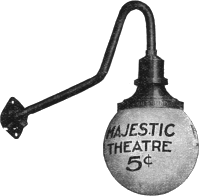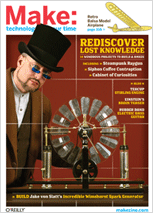

This week’s Lost Knowledge column is something of a link dump of resources I’ve collected in my research on Lost Knowledge, for MAKE Volume 17, and for this column. I want to grow it with additional resources, so if you know of decent repositories of information related to these subjects, please post them in the comments.

The New York Public Library maintains an online gallery of 700 years worth of scientific drawings. They can be viewed here. [via Brass Goggles]


John Jenkins is a private collector of radios and antique scientific apparatus who’s been collecting for some 35 years. His amazing collection, called the SparkMuseum, is available for viewing online. Absolutely incredible stuff here, from the dawn of electrical experimentation up to the vacuum tube.



You’ll need a robot translator to tell you what you’re looking at, but there are all sorts of cool steam-powered machinery on display. Lots of steampunky inspiration to be had at Stoommachine!


Early Technology is a Scottish firm that provides antique technology to collectors, museums, film sets, and others. From miner’s lanterns to adding machines.


The Western Electric Catalog & Yearbook 1916 is a digital version of this 1916 artifact, filled with hundreds of drawings and descriptions of the tools, equipment, and machinery sold by the Western Electric company at the turn of the century. Fascinating for armchair historians and a valuable resource for anybody doing retro-tech projects from this time period.


The Museum for Old Techniques (the MOT) is described (by the MOT itself) as:
An impressive, fascinating collection of tools, machines and water mills, library full of technical treatises and historical reference works, a series of activities for schools.
And they’re not exaggerating. Really amazing collection of things like “Belgian Trade Catalogues,” from the mid 1850s to the 1950s. One hundred years of trade-goods, scientific, and medical catalogs of every kind. In French, but the pictures alone are priceless for reference images.


Fueled by boutique-press publishing, the new craft movement, and high-profile endorsements from places like Martha Stewart Weddings, letterpress printing has been enjoying a revival in the last few years. Suddenly, antique letterpress machines, casting type, type drawers, and anything else to do with letterpress printing, is in high demand. There’s something undeniably awesome about typography and artwork visibly pressed into a gorgeous piece of high-quality paper stock. Green Dolphin Press are keepers of the venerable Internet letterpress FAQ Also, check out the amazing Briar Press Letterpress Museum.

A while back, Boing Boing Gadgets ran this how-to piece about building your own letterpress.

Old Wood Working Machines, aka OWWM, is a labyrinthian online library of manuals, photographs, and historical and restoration information about vintage woodworking equipment. The site has hundreds of PDF scans of old catalogs, product manuals, machine parts list, adverts, and historical documents from dozens of manufacturers. If you’re an enthusiast of “old iron,” you’ll go giddy wandering this impressive collection.

One of my favorite new electronic magazines of the moment is Low-Tech Magazine. It starts with the premise that every problem that we face does not necessarily need a high-tech solution — they’re basically suspicious of technology, without rejecting it outright. I don’t agree with all of their views, but where would be the fun in that, if I did? Lots of good stuff here on no-tech, low-tech, and alternative tech.

There’s Low-Tech, and then there’s No Tech, a sister site. Where Low-Tech has more in-depth pieces and editorials, No Tech has images and links and link round-ups.
More:
- Lost Knowledge: Homemade electronic components
- Lost Knowledge: Island tricks
- Lost Knowledge: Airships
- Lost Knowledge: The Catalog
- Lost Knowledge: The Antikythera Device
- Lost Knowledge: Village tech in West Papua, Indonesia
- Lost Knowledge: Neon lights
- Lost Knowledge: Reanimating Dead Media
- Lost Knowledge: Manual typewriters
From MAKE magazine:
Check out MAKE, Volume 17: The Lost Knowledge issue!

Buy your copy in the Maker Shed
Subscribe to MAKE
Access the Digital Edition (if you’re already a subscriber)
In Volume 17, MAKE goes really old school with the Lost Knowledge issue, featuring projects and articles covering the steampunk scene — makers creating their own alternative Victorian world through modified computers, phones, cars, costumes, and other fantastic creations. Projects include an elegant Wimshurst Influence Machine (an electrostatic generator built entirely from Home Depot parts), a Florence Siphon coffee brewer, and a teacup-powered Stirling engine. This special section also covers watchmaking, letterpress printing, the early multimedia art of William Blake, and other wondrous and lost (or fading) pre-20th-century technologies.
ADVERTISEMENT





